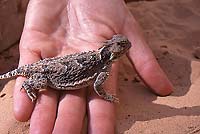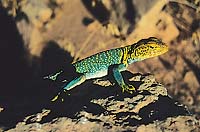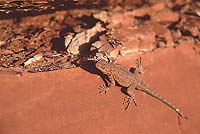As winter fades, spring arrives in fits and starts. Just look at a 10-day weather forecast in early March and you might see stretches of sunshine punctuated by afternoon snowstorms or bone-cleaning winds. But through all the wacky weather, one thing remains constant: it’s lizard time.
You could take that comment several ways. Scores of visitors descend upon the desert to soak up some sunshine after a long, gray winter. Sprawled out on the slickrock, these people take lounging like a lizard to new heights. Probably deficient in Vitamin D, they bask in the spring sunshine through March Madness or during a cobbled-together Spring Break.
But people aren’t the only ones seeking sunshine. Local reptiles with scaly skin and an ectothermic personality (requires external heat source) also emerge from their winter haunts. Unlike the endothermic humans (body heat produced internally) who are here on vacation, these reptiles need an external heat source, such as the sun, to warm their bodies.
Though they might make an appearance during an extended winter warming spell, small side-blotched and tree lizards probably didn’t emerge this winter. The reason these two smaller lizards might appear in winter is due to their small size and body mass. It doesn’t take much to heat up their slim 2-4” long bodies and set them running.
Reptiles enter a state of hibernation known as “brumation.” During this period, these reptiles may awaken for days, show a little activity, drink water if it is available, and then slip back from their brief wakefulness into dormancy.
Larger lizards such as the colorful collared lizard or the spotted leopard lizard usually stay tucked away in winter in deep burrows or beneath rock piles. These lizards will emerge when the weather really gets warm and stays that way. These lizards feed on insects and other lizards, so having the prey base established before they emerge is key to their survival.
Short-horned lizards, affably referred to as “horny toads,” are hockey-puck shaped lizards with short projections arising from their bodies. These “horns” contribute to the lizard’s common name. Sand colored, these lizards blend in with their surroundings, making them very easy to overlook. Their quick, scuttling movements often betray their presence, but their camouflaged coloration keeps them safe from marauding burrowing owls or other predators.
If cornered, the horny toad has another trick in its repertoire – squirting blood out sinuses located in their eye sockets to make a predator pause and give the lizard an opportunity to escape. 
Other reptiles that might appear in March, especially if the temperature really warms up and the nighttime lows are less than 20 degrees different than day time temps, are the snakes.
Snakes brumate together in winter dens, some which have been used for many years. They either exit the den en masse – seeing a rolling ball of garter snakes starting to unwind is an amazing site - or slither away separately, seemingly pouring out of the earth. Gopher snakes, midget-faded rattlesnakes, and whipsnakes might share one of these dens for the winter.
So as the weather warms in March, don’t be surprised to see reptiles sunning themselves on the sandstone, or lizard lounge, absorbing heat. And though the kids may be tempted to try and catch a lizard, please leave the wildlife alone and let them enjoy the desert sunshine just like everyone else.



